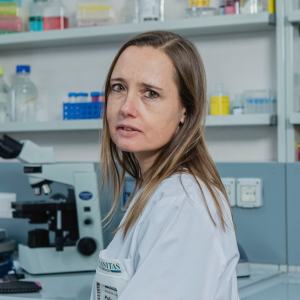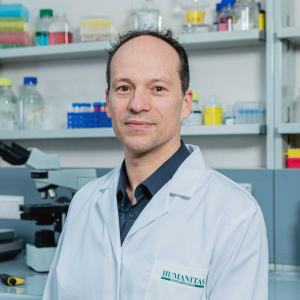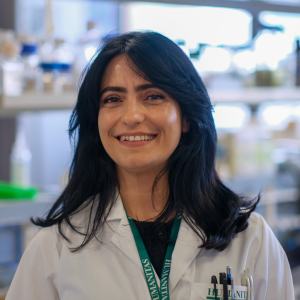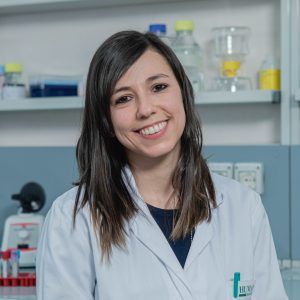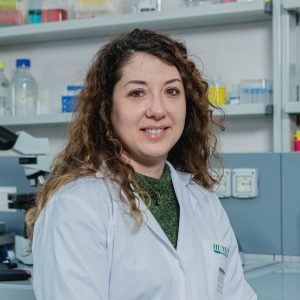Research Group
Catalucci Group
Signal Transduction in Cardiac Pathologies Lab
Our lab aims to dissect the molecular mechanisms underlying cardiac diseases to increase our knowledge on the organ functioning and to develop innovative and more effective approaches to treat the failing heart, such as nanodelivery of biologicals and personalized medicine.
The challenge
Many cardiac diseases lead to heart failure, a chronic condition that is the clinical endpoint of many cardiovascular disorders and one of the main causes of disability worldwide. We know that calcium plays a key role in cardiac contractility and thus in regulating the pumping function of the heart, while emerging evidence reveals that post-transcriptional mechanisms, including RNA editing processes, also critically influence cardiac pathophysiology. These molecular mechanisms, from calcium dysregulation to epigenetic modifications that alter protein function and gene expression patterns, represent interconnected pathways that contribute to diseased heart function. A deeper understanding of how these cellular processes interact and become disrupted in cardiac diseases will enable the development of innovative therapeutic strategies that leverage precision-medicine approaches and tailored drug delivery systems to target multiple aspects of cardiac dysfunction simultaneously.
Main research areas
Heart muscle contraction and calcium management
Understanding the cross-talk between stressed cardiac and immunological cells has recently gained significant attention in cardiovascular research. Over recent years, we have advanced our understanding of the subcellular regulation of the L-Type Calcium Channel (LTCC) complex, which serves as a key triggering factor in the Calcium Induced Calcium Release mechanism within cardiac cells. Our studies have investigated altered intracellular LTCC trafficking in various acquired and genetically based cardiac diseases, alongside the development of potential therapeutic interventions. Through this research, we aim to identify novel targets for therapeutic intervention in calcium-related cardiac dysfunction.
RNA therapeutics and editing in cardiac pathophysiology
Post-transcriptional regulation through RNA editing represents an emerging frontier in cardiovascular research, with particular focus on the A-to-I RNA editing mechanism in heart failure. This epigenetic process involves the conversion of adenosine to inosine in RNA molecules, potentially altering protein function and gene expression patterns in diseased cardiac tissue. Our research aims to identify specific RNA editing events that characterize pathological changes in heart failure and investigate innovative therapeutic strategies to modulate these editing patterns. By understanding how dysregulated RNA editing contributes to cardiac dysfunction, we explore the potential for targeted interventions that could restore normal post-transcriptional processing, offering novel therapeutic avenues for treating heart failure and other cardiovascular diseases.
Selected publications
Antimicrobial peptides for tackling cystic fibrosis related bacterial infections: A review.
Mitochondrial a Kinase Anchor Proteins in Cardiovascular Health and Disease: A Review Article on Behalf of the Working Group on Cellular and Molecular Biology of the Heart of the Italian Society of Cardiology.
Modulation of LTCC Pathways by a Melusin Mimetic Increases Ventricular Contractility During LPS-Induced Cardiomyopathy.
Biocompatible antimicrobial colistin loaded calcium phosphate nanoparticles for the counteraction of biofilm formation in cystic fibrosis related infections.
Synthetic recovery of impulse propagation in myocardial infarction via silicon carbide semiconductive nanowires.
Nano-miR-133a Replacement Therapy Blunts Pressure Overload-Induced Heart Failure.
Cardio Ultraefficient nanoParticles for Inhalation of Drug prOducts: when CUPIDO hits the nano-revolution in cardiology.
The role of mitochondrial dynamics in cardiovascular diseases.
Optimization of In Vivo Studies by Combining Planar Dynamic and Tomographic Imaging: Workflow Evaluation on a Superparamagnetic Nanoparticles System.
Peptide-Based Targeting of the L-Type Calcium Channel Corrects the Loss-of-Function Phenotype of Two Novel Mutations of the CACNA1 Gene Associated With Brugada Syndrome.
Novel Basic Science Insights to Improve the Management of Heart Failure: Review of the Working Group on Cellular and Molecular Biology of the Heart of the Italian Society of Cardiology.
Disease modeling of a mutation in α-actinin 2 guides clinical therapy in hypertrophic cardiomyopathy.
Wnt signalling mediates miR-133a nuclear re-localization for the transcriptional control of Dnmt3b in cardiac cells.
Inhalation of peptide-loaded nanoparticles improves heart failure.
Content of mitochondrial calcium uniporter (MCU) in cardiomyocytes is regulated by microRNA-1 in physiologic and pathologic hypertrophy.
T cell costimulation blockade blunts pressure overload-induced heart failure.
Peptidomimetic Targeting of Cavβ2 Overcomes Dysregulation of the L-Type Calcium Channel Density and Recovers Cardiac Function.
Bioinspired negatively charged calcium phosphate nanocarriers for cardiac delivery of MicroRNAs.
Neutrophils promote Alzheimer’s disease-like pathology and cognitive decline via LFA-1 integrin.
MicroRNA-133 modulates the β1-adrenergic receptor transduction cascade.
Atrogin-1 deficiency promotes cardiomyopathy and premature death via impaired autophagy.
The circulating level of FABP3 is an indirect biomarker of microRNA-1.
APJ acts as a dual receptor in cardiac hypertrophy.
Group members
